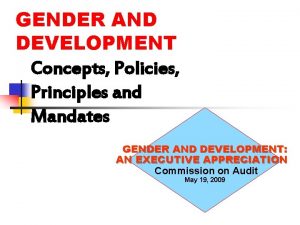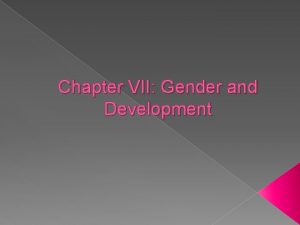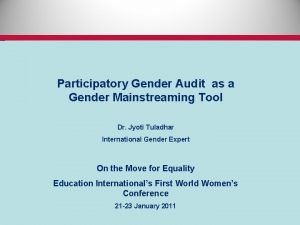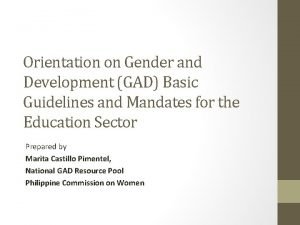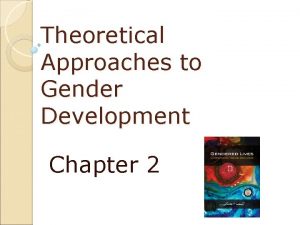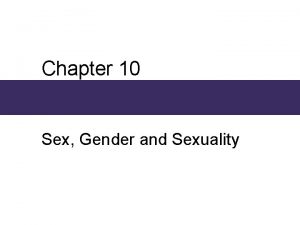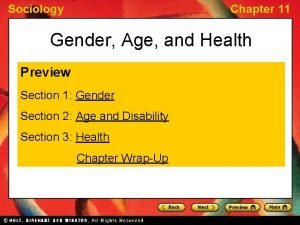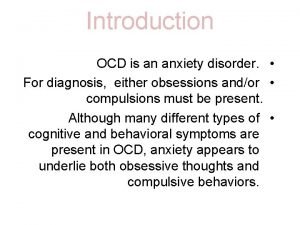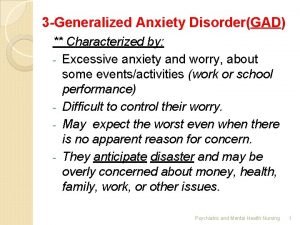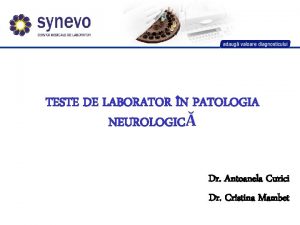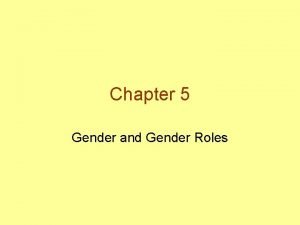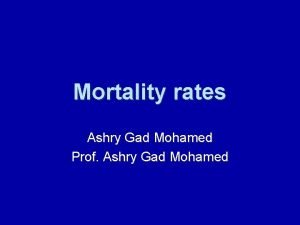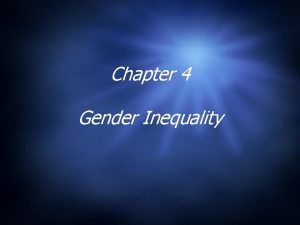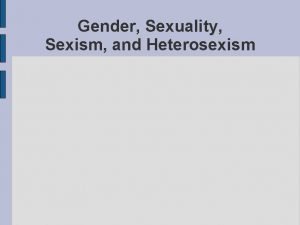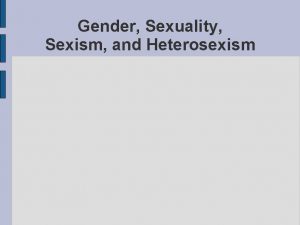CHAPTER THREE GENDER AND DEVELOPMENT GAD GAD and





















- Slides: 21

CHAPTER THREE GENDER AND DEVELOPMENT (GAD)

GAD and WID Approaches �In the 1950 s and onwards different theories and frameworks on development and women were discussed and presented from different perspectives. � Among these theories WID (women in development) ; GAD (gender and development) ; and empowerment were considered and adopted as most important approaches.

WID (WOMEN IN DEVELOPMENT)) � Esther Boserup (1970) for the first time used the term WID in her work Women’s Role in Economic Development. � "WID, " mean the integration of women into global processes of economic, political, and social growth and change,

�Later on, WID, began to be articulated by American liberal feminists : • It assumed that women were not participating in development; traditional roles were inhibiting (hindering) their self-development. Thus, to attain full participation in national development woman need to join productive employment in the modern sector. �

�The women in development (WID) further have been examined into three categories, including, q q q Equity; and Anti-poverty; Efficiency categories.

EQUITY AS APPROACH IN WID: The bases of this approach are on the assumption that economic development negatively effects upon females. Therefore, it suggested that benefits from development should equally be distributed among men and women. v

�In conclusion it can be said that the equity approach discusses the inequality between men and women, asks for political and economic equity for women.

v ANTI-POVERTY APPROACH IN WID It is known as the milder kind of the equity approach. o This approach got popularity in early 1970 s. o Anti-poverty approach paid attention to the reduction of income difference rather reduction in differential among women and men. o

This approach looks at women with low income with the aim of poverty reduction. �

v. EFFICIENCY APPROACH IN WID ü This approach got popularity in 1980 s and still has the same popularity. ü Accordingly, this approach ensures of making development further successful as well as efficiency by means of women’s economic contribution.

�Major philosophy of the approach is that the more the economic participation the more will be parity.

GAD (GENDER AND DEVELOPMENT) �The GAD concept appeared during 1980 s as result of disapprovals on the former idea of the WID. � It finds its theoretical roots in socialist feminism ( SF) and �SF identified the social construction of production and reproduction as the basis of women's oppression.

It focus on the relationship between women and development processes rather than purely on strategies for the integration of women into development. Or � Focused attention on the social relations of gender, � It examine why women systematically have been assigned to inferior and/or secondary roles. �

The GAD approach starts from a holistic perspective, �GAD is not concerned with women perse but with the social construction of gender and the assignment of specific roles, responsibilities, and expectations to women and to men. �

� The GAD approach welcomes the potential contributions of men who share a concern for issues of equity and social justice. � GAD also puts greater emphasis on the participation of the state in promoting women's emancipation,

�The GAD approach sees women as agents of change NOT passive recipients of development assistance. �

A key focus of GAD Strengthening of women's legal rights, including the reform of inheritance and laws , q. Coexistence of customary and constitutional legal systems in many countries and q The tendency for these to have been manipulated by men to the disadvantage of women. q 17

COMPARISON OF WID AND GAD �WID �GAD An approach that � An approach to views the absence of development that women in focuses on global and development plans gender inequalities and policies as the � The focus on Socially problem constructed relations � The focus on between women and Women men, with special focus on the subordination of women �

COMPARISON OF WID AND GAD �WID The problem : the exclusion of women (half of productive resources) from the development process � �GAD �The problem: Unequal power relations (rich vs poor; women vs men), which prevents equitable development and women's full participation

COMPARISON OF WID AND GAD WID � Its goal : more efficient, effective development that includes women. � GAD �Its goal : Equitable, sustainable development, with women and men as decisionmakers �

COMPARISON OF WID AND GAD WID �Its strategy focus on: women's projects, on women's components of projects, and on integrated projects � Increase women's productivity and income �GAD �Its strategy focus on : Reconceptualize the development process, taking gender and global inequalities into account
 Strategic gender needs and practical gender needs
Strategic gender needs and practical gender needs Gad objectives
Gad objectives Objectives of gender and development
Objectives of gender and development Gender and development
Gender and development Gender and development
Gender and development Sample lesson plan in gender and development
Sample lesson plan in gender and development Theoretical approaches to gender development
Theoretical approaches to gender development Differences between wid wad and gad
Differences between wid wad and gad Chapter 10 sex gender and sexuality
Chapter 10 sex gender and sexuality Chapter 11 gender age and health review worksheet answers
Chapter 11 gender age and health review worksheet answers Gad training topics
Gad training topics Chapter 10 physical development from one to three
Chapter 10 physical development from one to three Expenses that can be charged to gad budget
Expenses that can be charged to gad budget Gad accounting
Gad accounting Ego-dystonic example
Ego-dystonic example Gad diagnosis
Gad diagnosis Anticorpi anti gad valori normale
Anticorpi anti gad valori normale Wid wad gad
Wid wad gad Ano
Ano Gad-7 scoring
Gad-7 scoring Gad levanon
Gad levanon Hobbits and orcs problem
Hobbits and orcs problem

